Nội dung bài viết
AC and DC are the two most popular charging stations in the electric vehicle charging station infrastructure worldwide. However, not all users clearly understand these two types of charging stations, as well as how to differentiate in detail. In this article, we will analyze for you the differences between AC and DC charging stations.
Learn about AC electric vehicle charging stations

What is an AC charging station?
An AC charging station is a type of charging station that uses alternating current (AC) from the grid to fully charge the battery of an electric vehicle through the AC/DC current converter (On-Board Charger – OBC) built into the vehicle.
AC is the standard form of electrical current supplied by the power grid, however electric vehicle batteries can only receive DC current. Therefore, to be stored in electric vehicle batteries, AC current needs to be converted into DC current. This process is considered effective but time consuming, which is why AC charging is also known as slow charging. In return, AC charging is the optimal choice to help save costs as well as protect the life of EV batteries.
Operating principle of AC charging station
The AC charging station works by providing AC power to the OBC converter to generate DC current suitable for the electric vehicle battery.
This process requires synchronous and fast communication between the charge controller and the vehicle’s control system. After the OBC performs the conversion process, the power controller will receive information from the Battery Management System (BMS) to automatically adjust the appropriate voltage and current for the battery and control the entire battery charging process including temperature, charge level and other parameters. The BMS is also capable of activating a protection circuit in the charger to isolate the battery if it detects an overload.
Classification of AC charging stations
The International Electrotechnical Organization (IEC) divides AC charging stations into 3 levels as follows:
- Level 1: Charge slowly from a regular electrical outlet.
- Level 2: Slow charging from a regular outlet, with additional protection for electric vehicles.
- Level 3: Slow or fast AC charging using a dedicated multi-pin socket with control and protection functions.
Meanwhile, the Society of Automotive Engineers (SAE International) classifies AC charging stations into 2 levels according to SAE J1772 standard:
- Level 1 AC charging station: Uses a 120V residential power source (North American standard), compatible with any regular electrical outlet, capable of providing 6 – 16A current depending on the capacity of the dedicated circuit. However, the speed of this type of charging station is relatively slow, it usually takes from 8 to 20 hours to fully charge an electric vehicle’s battery.
- Level 2 AC charging station: Uses a 240V (single phase) or 208V (three phase) power source to provide a current of 6 – 80A with a significantly increased charging speed compared to level 1 AC charging. This is the most popular electric vehicle charging station today, often appearing in commercial centers, residential areas, and business parking lots, providing the ability to fully charge in just 6 – 9 hours, suitable for traveling distances of 120 – 170km.
Learn about DC electric vehicle charging stations
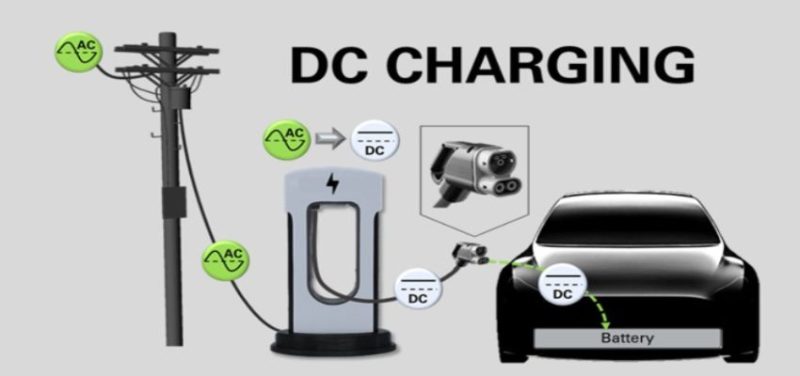
What is a DC charging station?
The DC charging station is a fast charging station for electric vehicles, directly providing DC current to the vehicle battery without going through the vehicle’s integrated OBC current converter. DC charging allows electric vehicles to be charged at high power, significantly shortening charging times.
Operating principle of DC charging station
The DC electric vehicle charging station operates according to the following process:
- Current conversion: The DC charging station is still connected to the AC power source of the grid, but the conversion process from AC to DC is performed by an inverter built into the station.
- Automatically identify: The DC charging station has the ability to automatically identify the electric vehicle’s connection port, then adjust the appropriate current and voltage to ensure an optimal and safe charging process.
- Charging the car battery: Instead of having to go through the OBC converter on the vehicle, DC electricity will be fed directly from the charging station into the electric vehicle battery. With large capacity, DC charging allows electric vehicles to be fully charged in a short time.
According to IEC classification, DC fast charging belongs to level 4 among popular types of electric vehicle charging stations, with the ability to fully charge 80% of the car battery in just about half an hour depending on the capacity of each vehicle type.
What’s the difference between AC and DC electric vehicle charging stations?
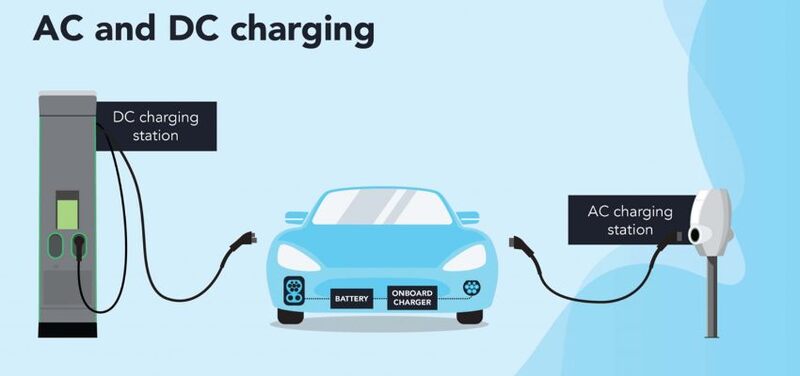
AC and DC electric vehicle charging stations, except for having the same task of providing energy to the battery of electric vehicles, are different in many criteria.
Current conversion process
Basically, AC and DC charging stations both take AC power as input and DC power output for electric vehicle batteries.
However, the AC – DC conversion process at the AC charging station takes place in the built-in OBC converter in the electric vehicle. Meanwhile, DC charging stations have the ability to convert alternating current to direct current right at the station, thus shortening the conversion process in the car, allowing DC current to flow directly from the station into the battery.
Charging curve
With AC charging, the current flowing from the charger to the vehicle battery is mostly flat, meaning the AC station will charge at roughly the same rate from 0 – 100% of the battery. This is because the vehicle’s built-in converter is relatively small and therefore limited in its ability to handle current.
Conversely, by bypassing the in-vehicle converter, DC charging can unlock much greater power output than AC charging, allowing electric vehicle batteries to take on large currents when first charged and gradually reduce them as the battery nears full capacity.
Therefore, with a DC charger, your electric vehicle can be charged to 80% battery in just about 30 minutes to 1 hour but it takes the same amount of time to fill the remaining 20% of the battery.
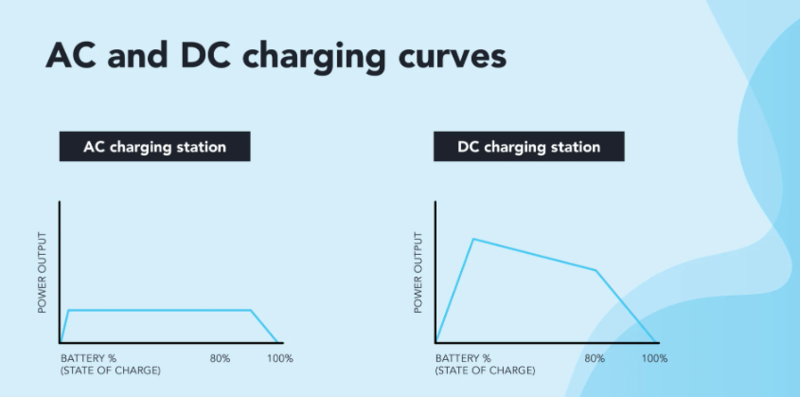
Charging port type
AC charging stations usually use 2 types of standard charging ports: Type 2 port (European and Vietnam regions) and Type 1 port (North American region).
Meanwhile, the DC charging station uses CCS (Combo Charging System) and CHAdeMO charging ports. Some other fast charging stations may have additional GB/T ports.
Charging time
Due to its low capacity, AC charging stations take longer to fill the battery than DC charging stations. A DC charging station can fully charge a battery in just 1 hour or less to 80% battery capacity.
Impact on electric vehicle batteries
If DC charging is used continuously, the performance and durability of electric vehicle batteries may be affected due to frequent exposure to high heat. With an AC charging station, although charging time is slow, receiving power evenly over a long period of time helps extend the life of the battery.
Expense
DC charging stations have much more expensive investment and charging costs than AC charging, so they are only suitable for charging in long-distance travel situations or when there is urgent waiting time.
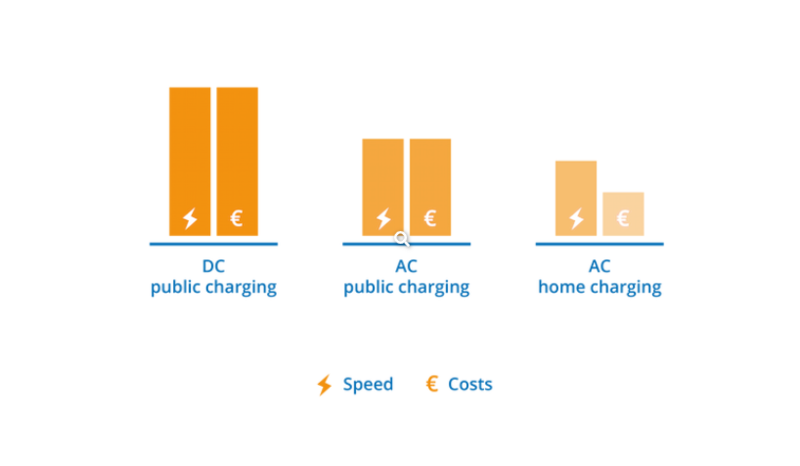
Installation location
AC charging stations are easy to find in many inner-city areas such as shopping centers, parking lots, apartment buildings, and even households. While DC charging stations are often located on national highways, expressways, and service stations, where there is a need for fast charging.
Summarize the differences between AC and DC charging stations in the table below:
| Criteria | AC charging station | DC charging station |
| AC – DC conversion process | Done at the vehicle’s built-in OBC converter | Done at the integrated converter in the station, providing DC current directly to the battery |
| Charging level | Level 1, Level 2 | Level 3 or Level 4 (according to IEC) |
| Charging time | 8-12 hours (Level 1), 3-8 hours (Level 2) | 30 minutes – 1 hour or less for 80% battery |
| Size | Compact, portable type | Larger, not portable |
| Investment costs and charging fees | Short | High |
| Charging port | Type 1, Type 2 | CHAdeMO, CCS |
| Installation location | Homes, offices, parking lots, public charging stations | Public charging stations on highways and national highways |
Should I choose AC slow charging or DC fast charging?
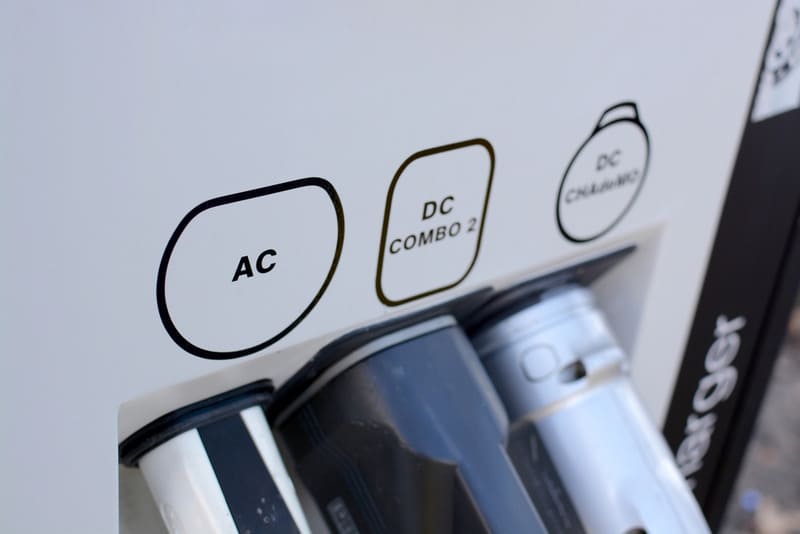
To choose the right type of charging station, you first need to clearly identify the advantages and disadvantages of these two common types of charging stations, then consider your actual needs to decide whether to choose fast charging or slow charging.
Advantages and disadvantages of AC charging stations
Advantage:
- Compatible with many vehicles: Since most electric vehicles today have a built-in OCB adapter, one AC charging station can serve a variety of electric vehicle models, providing greater flexibility and accessibility.
- Save installation costs: Installing an AC charging station is often simpler and less expensive than DC charging stations. The reason is that AC charging can take advantage of available grid power, limiting the cost of upgrading specific infrastructure such as DC charging.
- Durable and stable operation: AC chargers are often more grid-friendly than DC chargers, leading to more stable and durable operation of the AC charging station. In addition, slow charging is the optimal solution to maintain the life of EV batteries.
- Cheap charging cost: The charging fee of an AC station is much cheaper than a DC station, making it an economical choice when there is a need for daily charging.
The biggest disadvantage of AC charging is the slow charging speed. An AC charging station usually takes an average of 4 – 10 hours to fully charge an electric vehicle, so it is not suitable for instant charging needs.
Therefore, the AC charging station will be the ideal choice for daily charging needs, overnight charging at home, apartment or workplace. For households, AC charging stations are also an economical and effective solution for installation and use.
Advantages and disadvantages of DC charging stations
Advantage:
- Fast charging speed: The DC charging station only takes 30 minutes – 1 hour to charge 80% of an electric vehicle battery.
- Convenient when traveling long distances: DC charging stations are often installed on highways and national highways, allowing fast charging in a short time.
- Power supply can be expanded: The DC charging station is capable of expanding capacity from 50kW up to 350kW.
Disadvantages:
- High investment costs: DC charging stations require a stable 3-phase power source and good technical infrastructure.
- High charging costs: Because it is fast charging in a short time, the DC charging fee is also higher than AC charging.
- Not suitable for home installation: DC charging stations consume a large amount of power, so the civil power network does not have enough capacity to serve it. Therefore, private charging stations often do not use fast charging. DC chargers are also not suitable for mobility due to their bulky design and structure.
- Effect on car battery life: Frequent fast charging can generate heat and overload the battery, which over time will affect the battery’s lifespan.
With the above advantages and disadvantages, fast charging stations are often installed at rest stops on national highways and expressways to serve the urgent and short-term charging needs of electric vehicle users traveling long distances. In particular, this type of charging station is not suitable for installation at home but is often the choice of charging station investors or transport units to serve more electric vehicles in the same charging time as AC charging.
Frequently asked questions when distinguishing between AC and DC electric vehicle charging stations
Question 1: Does the battery in an electric car use AC or DC current?
Reply: Electric vehicle batteries only receive DC current, so alternating current from the grid needs to be rectified to be stored in the battery.
Question 2: Why is DC charging faster than AC charging?
Answer: DC charging is faster than AC charging because the conversion process from AC to DC current takes place directly at the charging station, bypassing the vehicle’s built-in converter. In addition, the DC charging station has a larger capacity, allowing it to fill the battery faster.
Question 3: Is AC or DC charging better?
Reply: Because each type of charging station has its own advantages and disadvantages, whether AC charging or DC charging is better depends on your needs. AC chargers are ideal for overnight charging, slow charging, and charging for everyday use. On the contrary, DC charging is the savior for fast charging needs, on long trips.
Question 4: Is DC charging harmful to electric vehicles?
Reply: Industry experts recommend that if you do not need to charge urgently or quickly charge in a short time, you should prioritize using slow AC charging every day because continuous DC charging can put pressure on the battery, increasing the wear rate of the electric vehicle battery, thereby affecting the life of the vehicle battery.
Question 5: Should businesses invest in AC or DC charging?
Reply: DC charging has the outstanding advantage of very fast charging time but comes with a series of disadvantages such as high investment and operating costs, requires a stable 3-phase power source, bulky size and cannot be portable. Therefore, if businesses do not sell charging stations, they should invest in the more optimal and economical option of AC charging stations.


Nội dung được phát triển bởi đội ngũ truonglehongphong.edu.vn với mục đích chia sẻ và tăng trải nghiệm khách hàng. Mọi ý kiến đóng góp xin vui lòng liên hệ tổng đài chăm sóc: 1900 0000 hoặc email: hotro@truonglehongphong.edu.vn